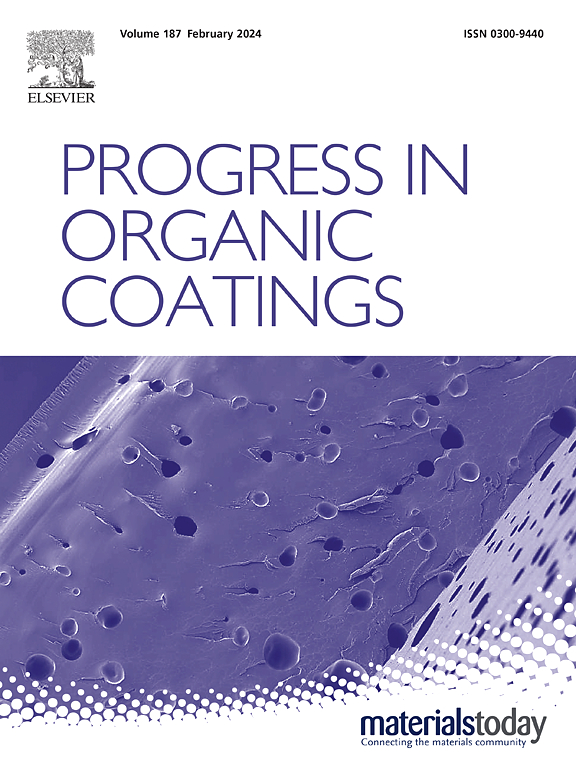High-performance and sustainable clear water-based coatings for outdoor wood protection: A review
IF 7.3
2区 材料科学
Q1 CHEMISTRY, APPLIED
引用次数: 0
Abstract
Clear water-based coatings have emerged as a promising solution to preserve the natural appearance of wood while enhancing its durability. However, achieving long-term stability in outdoor environments remains a major challenge for commercially available clear coatings. This study explores the potential of nanomaterials in improving the performance of these coatings. Inorganic nanoparticles can enhance UV resistance, transparency, mechanical strength, water repellency, and thermal stability. On the other hand, organic nanomaterials such as nanocellulose offer reinforcement capabilities, thermal stability, and biodegradability. However, challenges such as proper dispersion of nanomaterials in coatings, long-term durability, cost, and environmental and health impacts must be addressed. To overcome these obstacles, synergistic strategies combining various nanomaterials with complementary properties, hybrid nanocomposite systems, surface-modified nanomaterials, and multifunctional nanomaterials have been investigated. Additionally, emerging nanomaterials such as two-dimensional (2D) nanomaterials, self-healing materials, and biomimetic materials present new opportunities for the development of high-performance and sustainable clear wood coatings. This study highlights the importance of interdisciplinary collaborations, comprehensive assessments of environmental and health impacts, and the establishment of appropriate standards and guidelines. The advancement of these coatings can promote the widespread adoption of wood as a low-maintenance, visually appealing, and environmentally sustainable material for outdoor applications.

高性能、可持续的户外木材保护用透明水性涂料研究进展
透明水性涂料已经成为一种很有前途的解决方案,既能保持木材的自然外观,又能提高其耐久性。然而,在户外环境中实现长期稳定性仍然是商用透明涂料面临的主要挑战。本研究探讨了纳米材料在改善这些涂层性能方面的潜力。无机纳米颗粒可以增强抗紫外线、透明度、机械强度、拒水性和热稳定性。另一方面,有机纳米材料如纳米纤维素具有增强能力、热稳定性和生物可降解性。然而,诸如纳米材料在涂料中的适当分散、长期耐久性、成本以及对环境和健康的影响等挑战必须得到解决。为了克服这些障碍,研究人员研究了将各种具有互补性能的纳米材料、杂化纳米复合材料、表面改性纳米材料和多功能纳米材料结合在一起的协同策略。此外,新兴的纳米材料,如二维(2D)纳米材料、自修复材料和仿生材料,为开发高性能和可持续的透明木器涂料提供了新的机会。这项研究强调了跨学科合作、全面评估环境和健康影响以及制定适当标准和准则的重要性。这些涂料的进步可以促进木材作为一种低维护,具有视觉吸引力和环境可持续性的户外应用材料的广泛采用。
本文章由计算机程序翻译,如有差异,请以英文原文为准。
求助全文
约1分钟内获得全文
求助全文
来源期刊

Progress in Organic Coatings
工程技术-材料科学:膜
CiteScore
11.40
自引率
15.20%
发文量
577
审稿时长
48 days
期刊介绍:
The aim of this international journal is to analyse and publicise the progress and current state of knowledge in the field of organic coatings and related materials. The Editors and the Editorial Board members will solicit both review and research papers from academic and industrial scientists who are actively engaged in research and development or, in the case of review papers, have extensive experience in the subject to be reviewed. Unsolicited manuscripts will be accepted if they meet the journal''s requirements. The journal publishes papers dealing with such subjects as:
• Chemical, physical and technological properties of organic coatings and related materials
• Problems and methods of preparation, manufacture and application of these materials
• Performance, testing and analysis.
 求助内容:
求助内容: 应助结果提醒方式:
应助结果提醒方式:


